| dc.description.abstract | Cholelithiasis is a common clinical condition in patients with sickle cell disease and there are conflicting reports on laboratory indices useful in predicting those patients who are likely to have gallstones. There is however lack of similar studies from Kenya. We therefore studied the role of clinical (Body Mass Index), haematological (reticulocyte count, haemoglobin level), and biochemical (serum bilirubin: direct and indirect, serum alkaline phosphatase, serum transaminase) indices in predicting sickle cell anaemia patients likely to develop gallstones. A cross sectional descriptive study was conducted from October 1993 to December 1994 on consecutive male and female patients of all ages with homozygous sickle cell disease (HbSS) confirmed by cellulose acetate paper electrophoresis. A total of 64 patients aged between three and 37 years were recruited into the study. They were classified into two groups: stone formers and non-formers. The difference in the two groups with respect to clinical, haematological and biochemical indices were determined by Chi-square contingency test. Body mass index (BMI), reticulocyte count and alkaline phosphatase were found to have a significant positive association with increased likelihood of gallstone formation at p values of 0.004, 0.007 and 0.007, respectively. The rest of the study indices had no association. The cut-off points were reticulocyte counts above ten per cent and alkaline phosphatase levels above 13 K.A. units. Though sickle cell anaemia patients with BMI > 20 had significant increased likelihood of cholelithiasis, we could not determine its cut-off value. | |

